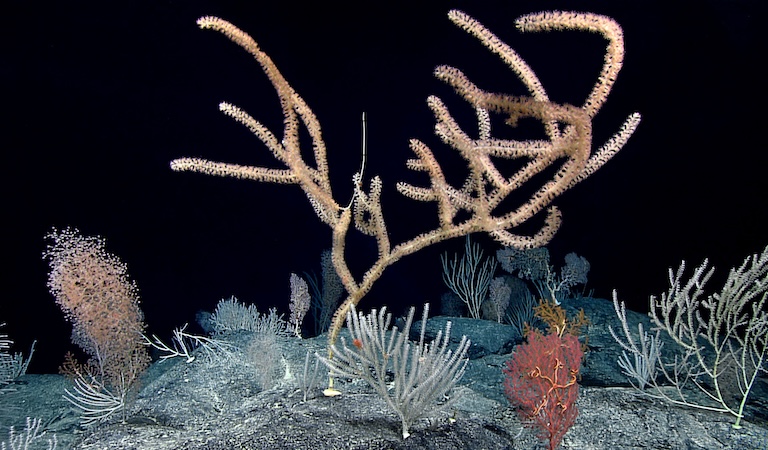Harvey Mudd Professor Cathy McFadden Co-Authors Study on Bioluminescence
April 24, 2024
The twinkling lights of fireflies can make a warm summer evening seem magical. This unique characteristic of producing and emitting light through a chemical reaction in the body, known as bioluminescence, is exhibited by other living organisms such as glow worms, firefly squid, comb jelly and some fungi. It’s also a trait observed among deep-sea octocorals, the subject of a new study co-authored by Cathy McFadden, Vivian and D. Kenneth Baker Professor in the Life Sciences.
The study, “Evolution of bioluminescence in anthozoa with emphasis on octocorallia,” was published in Proceedings of the Royal Society B, the main research journal of The Royal Society of London for Improving Natural Knowledge. Fellow co-authors include Danielle DeLeo, research associate at the Smithsonian Institution’s National Museum of Natural History (NMNH); Steve Haddock ’88, senior scientist and marine biologist at the Monterey Bay Aquarium Research Institute; and Andrea Quattrini, curator of corals at NMNH and a former postdoc researcher (2015–2019) in McFadden’s lab.
McFadden has spent years researching the diversity of octocorals, expert ecosystem designers who build their own animal forests along dark sea floors and prey on passing organic material. At Harvey Mudd, McFadden and Quattrini worked together to intricately map the evolutionary trees of various species of octocorals, providing a framework for their relationships. At the time, the tools they developed to make these maps were novel for research in the field; now, they’re used by research labs worldwide.
Bioluminescent proteins produced by octocorals are harvested and used widely in biomolecular research. The impetus for the study published this month was a desire to understand which octocorals produce bioluminescent proteins, how the organisms who do so relate to one another, and when the ability to make the proteins evolved. “Understanding the genetic and evolutionary path of bioluminescence in octocorals—which species have the ability to make bioluminescent proteins, the genes involved in creating the proteins, and how the trait itself has evolved—can help us further develop applications for bioluminescence in molecular biology and biomedicine,” says McFadden.
In addition to its potential for further application in biomolecular research, the study will be the first that dates bioluminescence among octocorals in evolutionary terms. “Historical analysis has suggested that it’s a trait that evolved a very long time ago in organisms it occurs in,” says McFadden. “In crustaceans, it may have been 250 million years ago and in others, such as fireflies, it may have been more recent. The distribution of this trait we’ve seen in octocorals suggests it evolved for them more than 550 million years ago, suggesting they would have been among the first bioluminescent animals.”
Possible reasons for bioluminescence as a trait among many of the organisms that exhibit it include producing signals for attracting mates, communicating with other organisms and protecting oneself from predators. But researchers have wondered why octocorals, as organisms without eyes, would have the capacity to bioluminesce. They now believe that, for octocorals, the trait may have evolved to ward off predators or, a more magical explanation, according to McFadden: “Deep-sea octocorals have evolved this trait while shallow-water corals don’t have the same ability to bioluminesce, suggesting it could be a form of deep-sea illumination and signaling in a place where there aren’t sources of light.”
